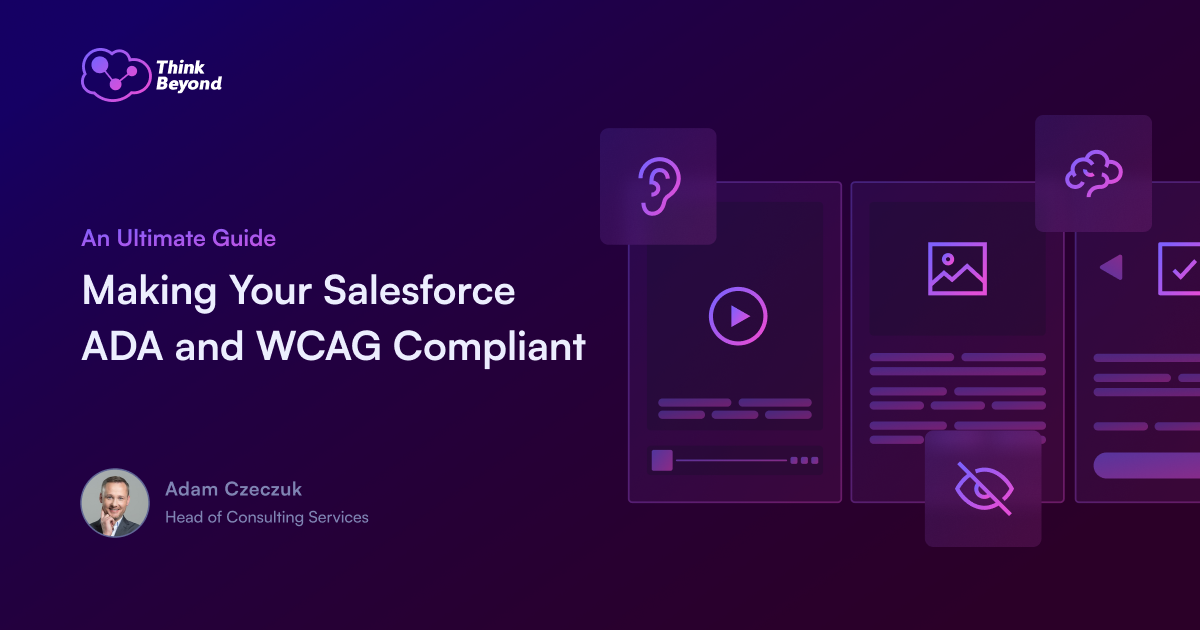Over a billion people worldwide live with some form of disability. Is your Salesforce platform excluding them? The growing importance of digital accessibility underscores both the legal and ethical imperative to ensure everyone, regardless of ability, can fully engage with your online platforms. For many businesses, Salesforce is the backbone of their operations. But while you’ve invested in this powerful tool, are you confident it meets the rigorous standards of ADA and WCAG compliance?
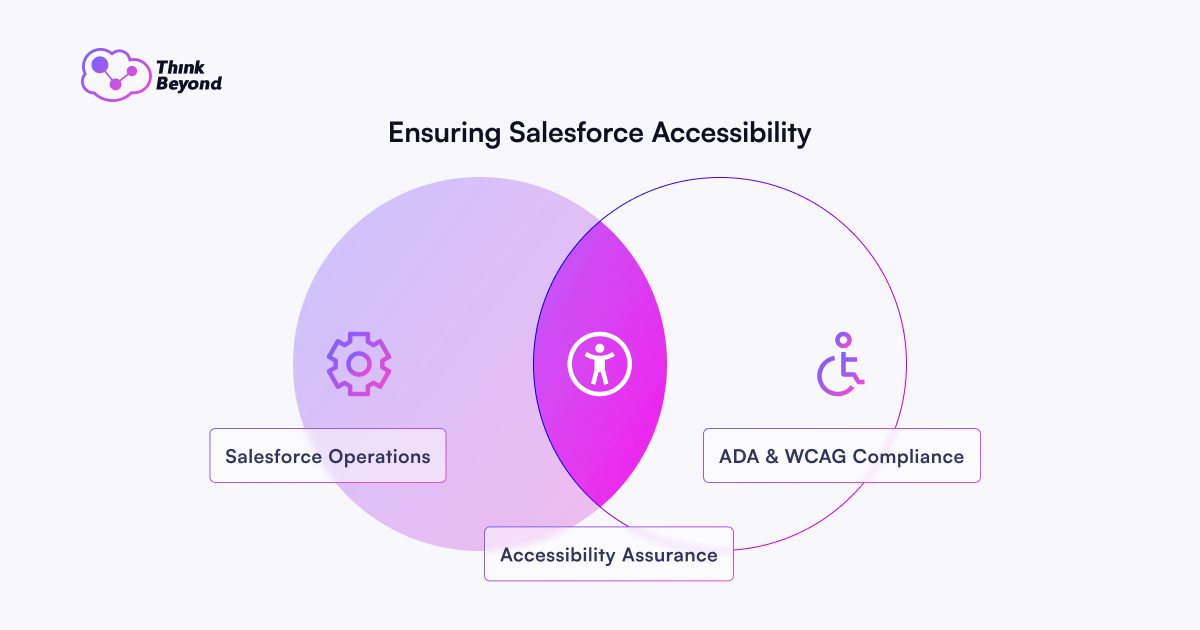
The reality is, many companies, even those deeply embedded in the Salesforce ecosystem, unknowingly fall short. This blog post is your roadmap to change that. We’ll cut through the complexity and provide actionable steps, empowering managers to transform the Salesforce environment into a truly inclusive and compliant platform.
Understanding the Basics of Web Accessibility: What are ADA and WCAG?
Web accessibility centers on designing websites that are usable by everyone, regardless of their abilities. By considering how people with varying capabilities interact with the web, it is possible to build inclusive platforms that remove barriers and promote equitable access.
At its core, accessibility ensures that individuals with diverse capabilities can independently use products, services, and facilities. In the digital realm, this translates to designing websites and applications with a focus on users with disabilities.
Specifically, when discussing web accessibility, we refer to two key frameworks: the Americans with Disabilities Act (ADA) and the Web Content Accessibility Guidelines (WCAG).
- The ADA is a civil rights law that prohibits discrimination against individuals with disabilities, mandating equal access in various areas, including online spaces.
- WCAG, on the other hand, provides the technical guidelines for making web content more accessible.
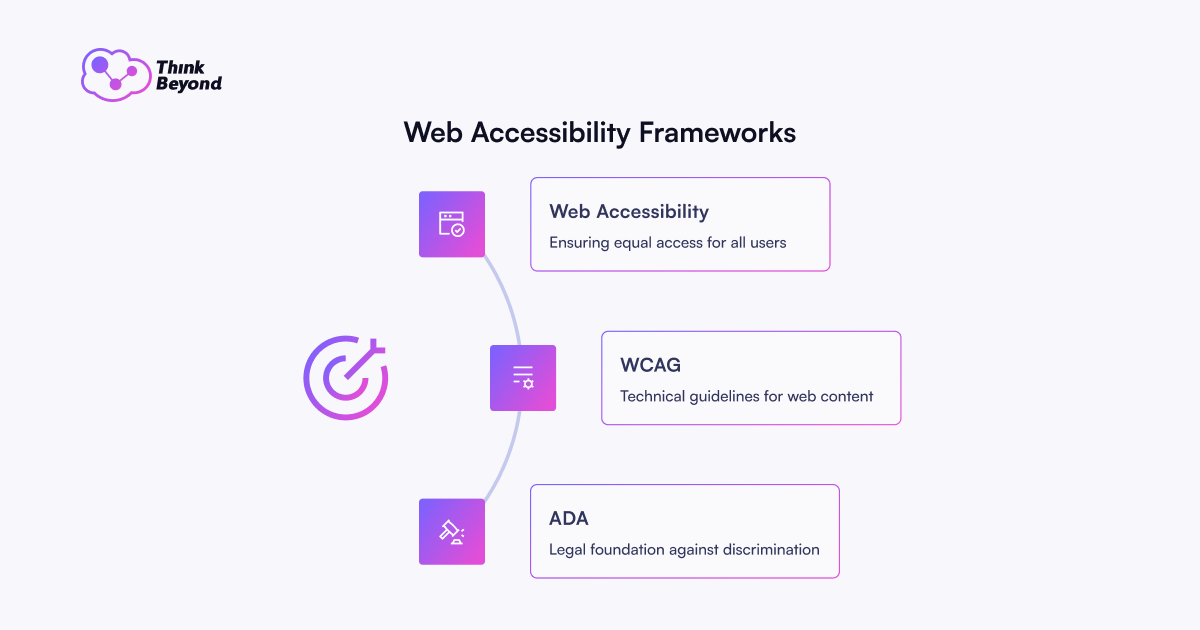
These guidelines address the five primary categories of disabilities: vision, auditory, physical, cognitive, and speech, ensuring that digital content is perceivable, operable, understandable, and robust for all users. Essentially, the ADA sets the legal foundation for non-discrimination, while WCAG offers the practical, technical roadmap for achieving it.
Why is ADA and WCAG Salesforce Compliance Important?
Accessibility within your Salesforce platform is crucial for a variety of reasons:
- Risk mitigation: Ensuring compliance with regulations like the ADA is essential to mitigate risks and avoid potential lawsuits that can damage both finances and reputation.
- Inclusivity: By making Salesforce accessible, you open your services to a wider audience, demonstrating a strong commitment to inclusivity that positively impacts your brand’s image and builds customer trust.
- User experience for everyone: Clear navigation, intuitive design, and accessible content lead to increased productivity and overall satisfaction across all users of your Salesforce system.
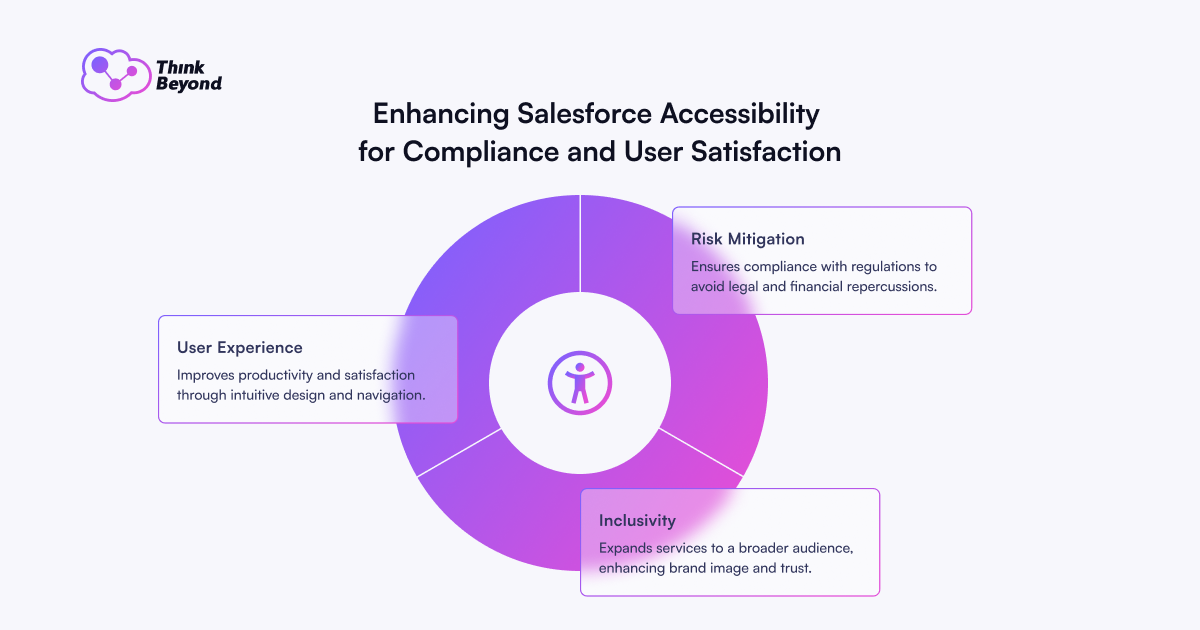
Salesforce Commitment to Accessibility
Salesforce recognizes the importance of digital inclusion and has made significant strides in its commitment to accessibility. This commitment is evidenced by their ongoing efforts to align with WCAG guidelines and improve the accessibility of their products.

Salesforce provides resources and documentation to help developers and administrators build accessible Salesforce experiences. Moreover, they continually update their platform to enhance compatibility with assistive technologies, demonstrating a dedication to creating a more inclusive digital environment. They also provide Accessibility Conformance Reports (ACR/VPAT) to clarify what level of accessibility their products have reached.
Salesforce and WCAG/ ADA: Practical Feature Examples
So, how does Salesforce make sure its platform is accessible to everyone? How does it ensure its platform is inclusive for users with disabilities? Here are some examples of features:
Accessibility Mode Features
- Simplified Navigation: Accessibility Mode includes features like a designated “Setup” link and streamlined dropdown menus with “Go” buttons, making navigation easier for users with assistive technologies.
- Popup Windows: Overlay pages are presented in separate popup windows for better clarity and accessibility.
- Improved Dashboard Usability: Dropdown menus in dashboards enhance filtering and navigation.
- Keyboard Navigation: Users can navigate the platform entirely via keyboard, bypassing the need for a mouse.
Screen Reader Support
Salesforce components are designed to work seamlessly with screen readers. For example:
- Labels are associated with input fields using HTML attributes like label and title, ensuring screen readers can describe the purpose of controls to users.
- Base Lightning components, such as lightning-input, come with built-in accessibility features that automatically associate labels with fields.
Visual Accessibility Enhancements
- Color Contrast: The platform adheres to WCAG standards for text-to-background contrast, making content legible for users with visual impairments.
- Global Color Styling Hooks: These ensure consistent color usage across components, avoiding reliance on color alone to convey information.
Accessible Drag-and-Drop
In tools like Content Builder, Salesforce has optimized drag-and-drop functionality for keyboard users by allowing components to be added or moved without a mouse. This ensures users with mobility impairments can interact effectively.
Customization for Specific Needs
Tailored interfaces have been developed for organizations, such as simplified layouts and skill-based search functionalities for visually impaired users. These include explicit explanations of screen elements and tab-based navigation.
Assistive Technology Compatibility
Salesforce integrates with assistive technologies like NVDA (NonVisual Desktop Access) and JAWS (Job Access With Speech), ensuring compatibility across various devices and tools used by individuals with disabilities.
Lightning Design System
The Lightning Design System provides developers with resources to create accessible components, such as keyboard-operable buttons and forms. It also includes guidelines for maintaining accessibility during custom Salesforce development services.
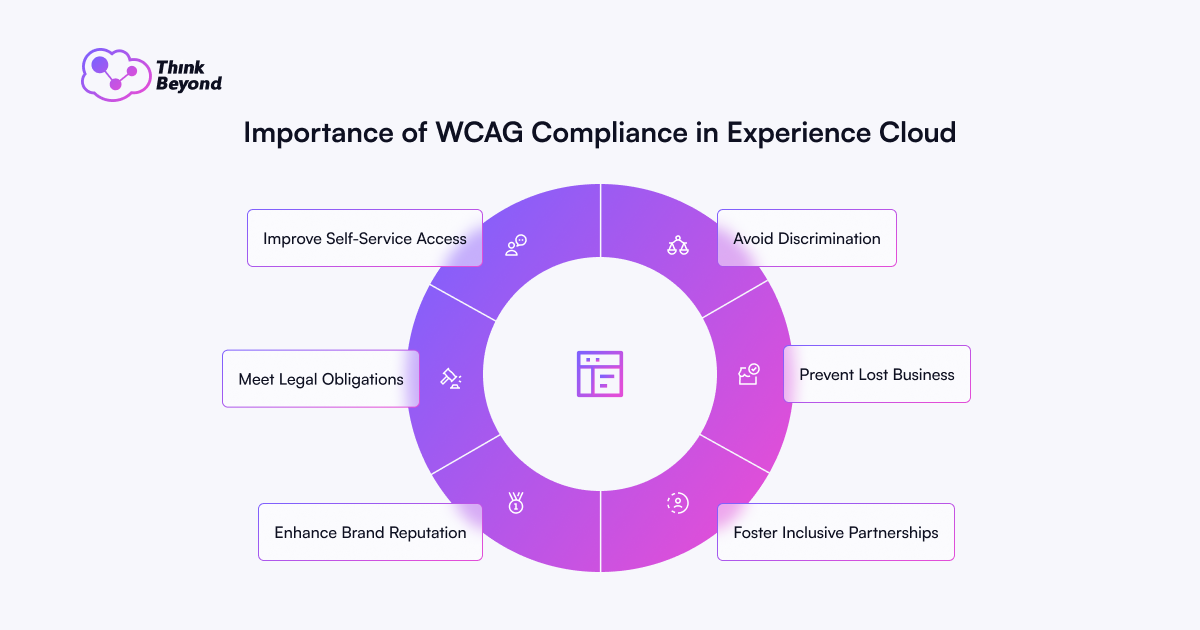
These features are a reflection of Salesforce’s commitment to accessibility. They meet different needs and comply with WCAG standards.
WCAG Updates: What are the Differences?
The regulations governing web accessibility are not static; they are in a state of continuous evolution, reflecting the dynamic nature of the digital landscape. This ongoing development is driven by two key factors: the rapid emergence of new technologies and the increasing societal awareness of the diverse needs of users with disabilities.
To understand the differences between WCAG 2.0, 2.1, and 2.2, it’s important to recognize that each version builds upon the previous one, aiming to enhance web accessibility for a wider range of users. What are the main characteristics of each of these regulations?
WCAG 2.0
This was the foundational version, published in 2008. It established core principles and guidelines for making web content more accessible. It became a solid base for digital accessibility, but as technology evolved, so did the need for more comprehensive guidelines.
WCAG 2.1
Published in 2018, WCAG 2.1 expanded upon 2.0 to address the evolving digital landscape. It recognized the rise of mobile devices and included guidelines for touchscreens and mobile-specific interactions. Added criteria to improve accessibility for those with visual impairments beyond complete blindness. And it was the first step to address the needs of individuals with cognitive and learning disabilities.
WCAG 2.2
The latest version, WCAG 2.2, further refines and expands upon 2.1.
It continues to emphasize cognitive accessibility with more refined and new success criteria. There are further refinements for mobile users. It also has additions that help with things like e-books and other digital content.
WCAG 2.2 is designed to keep pace with technological advancements and address the evolving needs of users with disabilities.
It is also important to note that WCAG 2.2 is designed to be backwards compatible. So, content that conforms to WCAG 2.2 also conforms to WCAG 2.1 and WCAG 2.0.

Each WCAG version represents a progression in web accessibility, with newer versions building upon previous ones to create a more inclusive digital environment.
WCAG and ADA: Looking Ahead
The future of WCAG is likely to be one of continuous evolution, driven by technological advancements and a growing emphasis on inclusive design.
What are the expected trends?
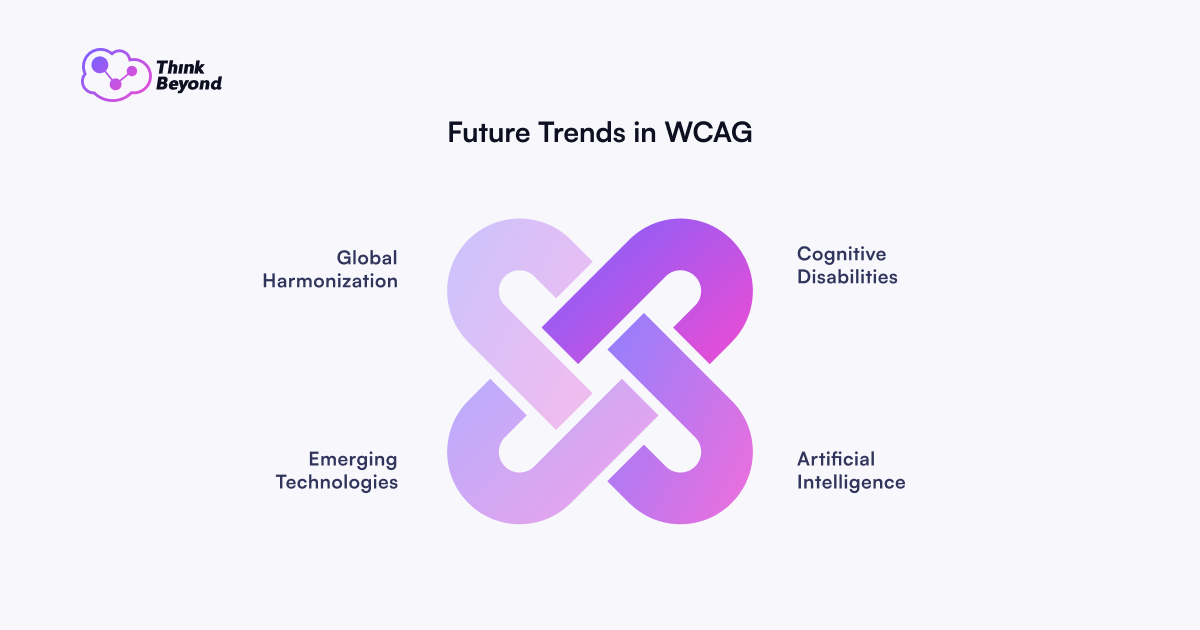
As awareness grows, expect WCAG to continue to refine guidelines for cognitive disabilities, including learning disabilities, ADHD, and memory impairments.
This will emphasize clear language, simplified interfaces, and predictable interactions.
Do not forget about AI, which has the potential to both improve and hinder accessibility. Future WCAG updates may address how AI-based features should be designed to be accessible.
And that’s not all. WCAG will need to adapt to new technologies, such as virtual reality (VR), augmented reality (AR), and the Internet of Things (IoT). Finally, efforts to harmonize accessibility standards across different countries and regions are likely to continue, leading to greater consistency and interoperability.
The changes in technology and our understanding of disabilities push regulators to constantly update accessibility rules. This ensures that the rules remain relevant and effectively guarantee everyone can use the internet, even as the digital landscape keeps evolving.
